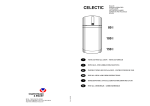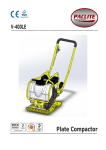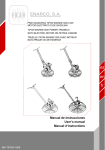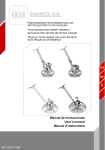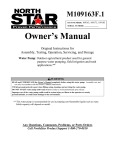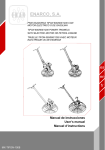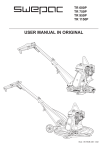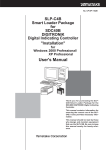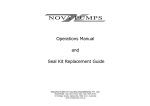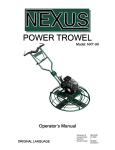Download FUJIBULL VPR150-200 Operation Manual
Transcript
Instruction Manual Vibratory Reversible Plate Compactor VPR150 Model VPR200 Model Table of Contents 1. INTRODUCTION……………………………………….1 2. SAFETY ………………………………………….…..1-2 3. SPECIFICATIONS……………..……………………….2 4. APPLICATION…..……………………………………2 5. CHECK BEFORE OPERATION……………………..3 6. OPERATING INSTRUCTIONS…………………….3-5 7. MAINTENANCE…………………………………………5 8. TRANSPORTATION………………………...………5-6 9. STORAGE………………………………………………..6 10. TROUBLESHOOTING………………………………….7 1. Introduction This manual has been written to help you operate your Reversible Plate Compactor safely. It is intended primarily for dealers and operators of FUJIBULL Reversible Plate Compactors. It is recommended that you keep this manual or a copy of it with the machine so that it is readily available for reference. Before you operate or carry out any maintenance on this machine YOU MUST READ and UNDERSTAND this manual. 2. Safety Personal For your own personal protection and Protective Equipment for the safety of those around you, (PPE) must be worn by the operator please read and ensure you fully whenever the equipment is being understand used. the following safety Cordon off the work area and keep information. It is the responsibility of the operator to ensure that he/she fully members understands unauthorised personnel at a safe how to operate this equipment safely. of the public and distance. If the surface to be compacted is on a slope, great care must be taken CAUTION Improper maintenance can when be controlling the machine’s hazardous. Read and understand this direction of travel. Always work up section and down a slope, not across. before you perform any Make sure you know how to safely maintenance, service or repairs. switch this machine OFF before you General Safety switch it ON in case you run into any The owner of this machine must difficulties. Always observe, and also train the user of switch OFF the engine before servicing it. the machine to observe, the effective This machine must be operated on labour protection laws in the country the of application. This machine is to be used for is ground where stability is guaranteed. When working near the rim of excavated trenches, use the intended application only. This machine must only be operated machine by well-trained personnel. 2 properly so that the machine may not collapse or fall must be informed of such an event down. for future counter measuring. During use, the engine becomes very hot. Always allow the engine to Fuel Safety cool down before touching it. CAUTION Never leave the engine running and Fuel is flammable. It may cause injury unattended. and property damage. Shut down the Never remove or tamper with any engine, extinguish all open flames and fitted guards; they are there for your do not smoke while filling the fuel tank. own protection. If they are damaged Always wipe up any spilled fuel. or missing, DO NOT USE THE Before re-fuelling, switch off the MACHINE until the guard has been replaced or repaired. Always switch engine and allow it to cool. OFF the When engine re-fuelling, use a proper before transporting it, moving it funnel, and avoid spilling over the around site or servicing it. engine. Do not operate the machine when When re-fuelling, DO NOT smoke or you are ill, feeling tired or when allow naked flames in the area. Spilt under the influence of alcohol or drugs. This fuel must be made safe immediately by using sand. If fuel is machine is designed to spilt on your clothes, change them. eliminate the possible risks arising Store fuel in an approved, purpose from the use of it. However, risks DO made container away from heat and reside, and these residual risks are sources of ignition. not clearly recognisable and may cause personal injury or property Health & Safety damage, and possibly death. If such Fuel unpredictable and unrecognisable Do not ingest fuel or inhale fuel vapors risks become apparent, the machine and avoid contact with your skin. Wash must be stopped immediately, and fuel splashes immediately. If you get operator or his supervisor must take fuel in your eyes, irrigate with copious appropriate measure to eliminate amounts of water and seek medical such attention as soon as possible. risks. It is sometimes necessary that the manufacturer 3 Exhaust Fumes CAUTION The exhaust fumes produced by this machine are highly toxic and can cause death. Make sure the work area is adequately ventilated. Suitable PPE must be worn when Component Material Handle Steel and Rubber Engine Base Ductile Iron Flexible Mounts Steel and Rubber Various Parts Steel and Aluminium beside provides you with a list of the using this equipment i.e. safety machine’s components and their goggles, gloves, ear defenders, dust mask and steel toe-capped footwear (with anti-slip soles for added protection). Wear clothing suitable for the work you are doing. Always protect skin from contact with respective concrete. The compaction produce dust, process which may recycling facilities. be wear a mask that is suited to the type of dust being produced. In order to protect the environment recycle any Take the discarded apparatus to the relevant can hazardous to your health. Always please materials. discarded apparatus or accessories. The table 4 3. Machine Description 1 7 8 2 4 3 9 5 6 1. Control Handle 2. Handle bar 3. Engine 4. Engine Base 5. Base plate 6. Side Covers 7. Lifting Eye 8. Safety Cover 9. Safety Bar Please note: Due to improvements and changes in the equipment, the illustrations shown may be different from the actual machine. 5 Maintenance Section). 4. Pre-Start Checks VI. Check for fuel and oil leaks. The following Pre-start-up inspection must be performed before the start of 5. Start and Stop Procedure each work session or after every four hours of use, whichever is first. Please refer to the service & maintenance CAUTION Improper operation can be hazardous. Read and understand this section before you start the machine. section for detailed guidance. If any fault is discovered, the Plate Compactor must not be used until the fault is Before starting the engine, make sure rectified. that the Safety Switch is in ON I. position, Throttle Lever is set to idle Thoroughly inspect the machine for position. signs of damage. Make sure all guards are in placed and secured. I. Take the Reversible Compactor to II. Check hoses, filler openings, drain where it is required. Use suitable plugs and any other areas for signs lifting equipment to position the of leakage. Fix any leaks before Reversible Compactor where it is operating. necessary. Make sure the lifting III. Check the engine oil level and top equipment has a WLL (Working up as necessary. Use proper engine Load oil with the proper viscosity (SAE Limit) Reversible 10W-30 recommended). suitable Compactor for the weight. Attach suitable slings or chains only IV. Check the engine fuel level and top to the lifting point. up as necessary. Use clean fuel. II. Never leave the engine running Use of contaminated fuel may during transporting, even if it is for a damage the fuel system. short period of time. V. Check the air filter is clean. III. Having carried out the checks listed Excessive dirt/dust accumulation in the ‘pre-start’ section, you may within the filter element will cause start the engine. FUJIBULL Plate erratic engine operation. Clean the Compactors air filter element when it is are fitted with a centrifugal clutch which allows the contaminated. (See Service & engine to run at idle speed without 6 driving the Plate Compactor. The IV. Centrifugal clutch will be engaged as compacted, 3 or 4 passes are the speed of engine is increased. recommended to achieve the best For correct operation, the engine compaction. speed should be set to maximum. V. Before Starting Gasoline Engine I. Check the engine moisture may cause soil particles crankcase. Be sure to maintain the to stick together and prevent good proper compaction. level oil in per the While a certain amount of moisture in the soil is necessary, excessive the engine manufacturer specifications. If the oil VI. is dirty and in need of changing, If soil is extremely wet, allow it to dry somewhat before compacting. follow the Engine User Manual VII. If soil is so dry as to create dust instructions. II. Depending on the material being clouds while operating Reversible Check the fuel supply. Refer to Compactor, some moisture should Engine User Manual. be added to the ground material to improve compaction. This will also reduce service to the air filter. 6. Operation I. VIII. When Run the engine at full throttle and Compactor allow the Reversible Compactor to plate When operating on an incline it Reversible paving to prevent stones, chipping grinding surface of stones. may be necessary to assist the Reversible Compactor by pushing it forward slightly. III. on the attach a pad to the bottom of the pull itself along at its normal speed. II. using When operating downhill hold the Reversible Compactor back slightly, if it begins to pick up speed. 7 or 7. Maximum Admissible Inclination 25°~30° 25°~30° Regarding Speed and Direction The plate compactor has a hydraulic system which enables a gradual increase in speed. The direction of travel is determined by the control on the guide pole. Application This Reversible Plate Compactor is designed for compacting loose, granular soils, gravel, paving stones and asphalt. It is intended to be used in confined areas and areas next to structures such as walls, curbs, and foundations. This Reversible PlateCompactor is not recommended for compacting cohesive soils with heavy clay content. For cohesive soil, use a Vibratory Rammer. 8 8. Service and Maintenance Parts Maintenance Air filter Check filter, clean or replace if necessary. Check oil level (only for models with bathed in oil filter.) Fuel tank Check tank lid fortight fit, replace if necessary. Interval Daily. Engine Check oil level, top up if necessary. Exciter Check for tightness. Engine First oil change. After 20 hours. V-belt Check V-belt tension. Monthly. Fuel tank Check fuel filter, replace if necessary. Engine Further oil changes. Exciter Check oil level – fill up, if need be. After 150 hours. Exciter Oil change. After 250 hours. After 100 hours. Engine Oil Change I. Check oil level using the proper dipstick. II. Effect oil exhaust with engine still warm. III. Fill up until fit level. WARNING Use oil with viscosity and characteristics prescribed by engine maker (look at engine manual). Dry Air Filter I. To prevent carburetor malfunctions, clean regularly air filter. II. Never use low flash point solvents for cleaning the air filter. III. Never run the engine without the air cleaner. Bathed in oil air filter I. Unhook the oil tank from filter. II. Remove used oil and add new oil until fit level. III. Remove dirt which is in the filter cap. 9 IV. Clean aspiration pipe. V. Check washer conditions, replace if necessary. Hydraulic system I. Move centre pole into vertical position. II. Open filler bore. III. Check oil level, top up if necessary. IV. Top up with hydraulic oil T68. V. Close filler bore. 9. Transportation and Storage CAUTIOON Extreme Care must be taken when transporting, loading or unloading this machine. For long-term storage, empty the fuel in the carburetor by running the engine with the fuel tap closed. The chemical composition of the fuel will deteriorate after prolonged storage. When the machine needs to be stored for a long time, remove all the fuel from the fuel tank and the water from the water tank. Also remove the fuel from the float chamber of the carburetor by draining the fuel out from the drain plug. Wash away excessive dirt accumulated on the Reversible Compactor. Clean the engine mounting plate. Cover the machine and store it in a dry place. Where applicable, always use the lifting hook for hoisting purposes. Use proper hoisting equipment and techniques. Be certain the area surrounding the machine is clear of personnel before hoisting. 10 10. Trouble Shooting PROBLEMS POSSIBLE CAUSES COUNTERMEASURES The machine does not go forward or goes forward slowly. Oil lack in the hydraulic pump placed on the handle. Place the handle in vertical position. Add hydraulic oil until the level indicated in the pump. Take off air from the circuit by lifting up and letting down the control levers sometimes. The machine goes only backward. The joint of the pump is broken or is worn out. Replace the joint. There is too much oil in the hydraulic pump placed on the control handle. Take off oil and restore the level indicated in the pump. There is some air under pressure in the pump. Open the pump plug in order to let air go out. Loss of oil in the hydraulic conduit. Replace the broken part. The cylinder joint of the exciter is broken or worn out so the oil goes in the exciter. Replace the joint and restore the oil level in the exciter. The machine does not go backward or goes backward slowly. The oil level in the pump is decreasing slowly. The belt is broken. The engine works regularly at fully capacity but the machine does not vibrate. The belt is loosening because it is worn out. Centrifugal clutch is broken. The engine works and the exciter vibrates but the machine keeps still. Mechanical failure in the exciter system. The engines works with difficulty, smoke comes from the clutch and the exciter strains. The mechanical parts in the exciter do not work well (worn out bearings, loss of oil, broken gears.) The engine turns at minimum RPM but the exciter does not stop. Centrifugal clutch is broken. Travel speed reduced or discontinuous. Engine RPM are over. Replace the belt. Replace the centrifugal clutch. Open the exciter and remove the failure. Address to an Assistance Service Centre. Open the exciter and replace the worn out parts. Address to an Assistance Service Centre. Replace the worn out parts. Check that during work accelerator lever is set at maximum. Adjust engine RPM with appropriate tool. 11 11. Specifications MODEL VPR150G/150D VPR200G/200D OPERATING WEIGHT - kg 150 / 155 190 / 197 Plate Size - (L x W) mm 500 x 650 700 x 600 WORKING WIDTH - mm (in) 650(25.6) 600 (23.6) VIBRATION FREQUENCY - Hz (V.P.M.) 90(5,400) 90(5,400) CENTRIFUGAL FORCE – KN(Kgf) 30(3059) 30(3059) COMPACTED AREA - m²/h (ft²/h) 650 759 COMPACTION DEPTH (DEPENDING ON SOIL) - cm (in) 70~85 70~85 25° 30° Honda GX160 / HATZ 1B20 Honda GX270 / HATZ 1B30 4-STROKE GASOLINE ENGINE / AIR- COOLED SINGLE CYLINDER 4 STROKE DIESEL ENGINE 4-STROKE GASOLINE ENGINE / AIR- COOLED SINGLE CYLINDER 4 -STROKE DIESEL ENGINE 4.6(3.5) 4.6(3.5) 3600 3600 MAX. GRADEABILITY - ° ENGINE ENGINE TYPE MAX. POWER OUTPUT - hp (kW) MAX. ENGINE SPEED - rpm 12













